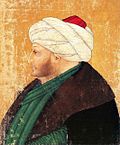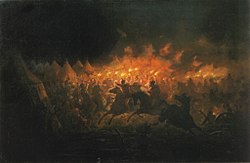Mehmed II
Mehmed II (Ottoman Turkish: [محمد ثانى] Error: {{Lang}}: text has italic markup (help); Turkish: [II. Mehmed] Error: {{Lang}}: text has italic markup (help), pronounced [icinˈdʒi ˈmehmed]; 30 March 1432 – 3 May 1481), commonly known as Mehmed the Conqueror (Ottoman Turkish: [ابو الفتح] Error: {{Lang}}: text has italic markup (help); Turkish: [Fâtih Sultan Mehmed] Error: {{Lang}}: text has italic markup (help)), was an Ottoman sultan who ruled from August 1444 to September 1446, and then later from February 1451 to May 1481. In Mehmed II's first reign, he defeated the crusade led by John Hunyadi after the Hungarian incursions into his country broke the conditions of the Peace of Szeged. When Mehmed II ascended the throne again in 1451, he strengthened the Ottoman navy and made preparations to attack Constantinople. At the age of 21, he conquered Constantinople (modern-day Istanbul) and brought an end to the Byzantine Empire, permanently cementing its destruction.
| Mehmed II | |||||
|---|---|---|---|---|---|
| Kayser-i Rûm (Caesar of the Romans) The Sultan of Two Lands and the Khan of Two Seas[1] | |||||
 Portrait of Mehmed II by Gentile Bellini, dating 1480 | |||||
| Sultan of the Ottoman Empire (Padishah) | |||||
| August 1444 – September 1446 | |||||
| Predecessor | Murad II | ||||
| Successor | Murad II | ||||
| 3 February 1451 – 3 May 1481 | |||||
| Predecessor | Murad II | ||||
| Successor | Bayezid II | ||||
| Born | 30 March 1432 Edirne, Ottoman Sultanate | ||||
| Died | 3 May 1481 (aged 49) Hünkârçayırı (Tekfurçayırı), near Gebze, Ottoman Empire | ||||
| Burial | Fatih Mosque, Istanbul, Turkey | ||||
| Consorts |
| ||||
| Issue |
| ||||
| |||||
| Dynasty | Ottoman | ||||
| Father | Murad II | ||||
| Mother | Mila Despinović (biological) Mara Branković (adoptive) | ||||
| Religion | Sunni Islam[3][4] | ||||
| Tughra |  | ||||
After the conquest Mehmed claimed the title Caesar of the Roman Empire (Ottoman Turkish: [قیصر روم] Error: {{Lang}}: text has italic markup (help)), based on the fact that Constantinople had been the seat and capital of the surviving Eastern Roman Empire since its consecration in 330 AD by Emperor Constantine I.[5] The claim was only recognized by the Patriarchate of Constantinople. Nonetheless, Mehmed II viewed the Ottoman state as a continuation of the Roman Empire for the remainder of his life, seeing himself as "continuing" the Empire rather than "replacing" it.
Mehmed continued his conquests in Anatolia with its reunification and in Southeast Europe as far west as Bosnia. After conquering Constantinople and getting the Byzantines out of the way, he started making more conquests in the Balkans and focused on his Balkan campaigns, even unsuccessfully laying siege to Belgrade in 1456 at one point. He was also known for his rivalry with Vlad the Impaler, who grew up at his father's court alongside him. Vlad the Impaler had taken control over Wallachia and rebelled against the Ottoman Empire, thus Mehmed II sent an Ottoman army, resulting in a war between the two. The war ended when Vlad was killed by an Ottoman patrol in Wallachia. He was then beheaded with some saying his head was sent to Mehmed II himself at the capital city Constantinople (modern Istanbul) by the Ottoman soldiers. He was also known for his campaigns against Albanian rebel leader Skanderbeg. For most of his reign, Mehmed II was on campaign against either John Hunyadi, Vlad the Impaler or Skanderbeg. Domestically, he made many political and social reforms, encouraged the arts and sciences, and by the end of his reign, his rebuilding program had changed Constantinople into a thriving imperial capital. He is considered a hero in modern-day Turkey and parts of the wider Muslim world. Among other things, Istanbul's Fatih district, Fatih Sultan Mehmet Bridge and Fatih Mosque are named after him.
Mehmed II Media
Roumeli Hissar Castle, built by Sultan Mehmed II between 1451 and 1452, before the Fall of Constantinople
The entry of Sultan Mehmed II into Constantinople, painting by Fausto Zonaro (1854–1929)
Portrait of Vlad (Dracula) the Impaler, Prince of Wallachia, 1460
The Night Attack of Târgovişte, which resulted in a failed assassination attempt of Mehmed
Mehmed II's ahidnâme to the Catholic monks of the recently conquered Bosnia issued in 1463, granting them full religious freedom and protection
Scene depicts the fifth and greatest assault upon the Shkodra Castle by Ottoman forces in the Siege of Shkodra, 1478–79
Related pages
References
- ↑ Cihan Yüksel Muslu (2014). The Ottomans and the Mamluks: Imperial Diplomacy and Warfare in the Islamic World. p. 118.
Mehmed presented himself to the world as The Sultan of two lands and the Khan of two seas
- ↑ Gustav Bayerle (1997). Pashas, Begs, and Effendis: A Historical Dictionary of Titles and Terms in the Ottoman Empire. Isis Press. p. 150.
- ↑ The Essential World History, Volume II: Since 1500. By William J. Duiker, Jackson J. Spielvogel
- ↑ The Rise of Turkey: The Twenty-First Century's First Muslim Power. By Soner Cagaptay
- ↑ Nicolle 2000, p. 85.
- Lord Kinross (1977). The Ottoman Centuries: The Rise And Fall Of The Turkish Empire. HarperCollins. ISBN 0-688-08093-6.
Other websites
| Wikimedia Commons has media related to Lua error in Module:Commons_link at line 62: attempt to index field 'wikibase' (a nil value).. |
- Biography page at OttomanOnline Archived 2010-12-13 at the Wayback Machine







